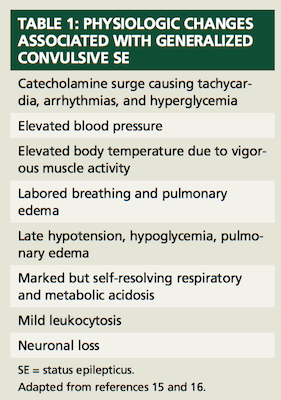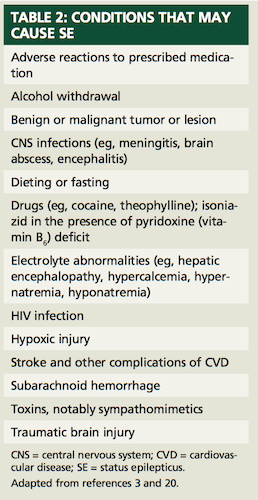Status Epilepticus: When Seizures Don't Stop
This state of continuous, unremitting seizure can be life-threatening and requires prompt emergency intervention.
This state of continuous, unremitting seizure can be life-threatening and requires prompt emergency intervention.
Status epilepticus (SE)—persistent, continuous, unremitting seizure or rapidly recurring seizures—represents seizure activity at the extreme. While most seizures terminate spontaneously in fewer than 5 minutes, no one knows why normal mechanisms sometimes fail and allow SE to develop. SE is common, with an incidence of up to 41 per 100,000 people annually, and also life-threatening, with an estimated mortality of about 20%.1-4 We tend to think of SE as a prolonged seizure of the clonictonic variety, but in actuality, SE occurs in a number of presentations.
SE may be the initial presentation of epilepsy in patients with no history of seizure, or an illness exacerbation in patients with documented epilepsy. Epilepsy and its complications are the cause in fewer than half of all cases of SE; it occurs pursuant to one of any number of neurologic insults, including infection, trauma, or stroke.3
Self-Sustaining Seizures
SE is generally defined as a state of persistent, continuous, unremitting seizure or rapidly recurring seizures that lasts more than 5 minutes or longer. Quick intervention is needed; 5 to 10 minutes is the threshold at which seizure activity is considered a medical emergency.5 At that point, neurologic damage begins to occur and the seizure is unlikely to resolve spontaneously. SE becomes epileptogenic (seizure sustaining) by enhancing hyperexcitable networks; the seizure becomes self-sustaining.6-9 The longer the SE continues, the more likely that excitatory neurotransmitters will damage neurons and the poorer the prognosis.10-12

SE may be convulsive or nonconvulsive. In both types, changes in electroencephalography (EEG) accompany SE. Usually, the patient loses consciousness or develops an altered sense of awareness. Coma may develop. Generalized convulsive SE is more common than nonconvulsive SE, accounting for 37% to 70% of cases.13 Convulsive SE is easily recognized by its sequential motor convulsions, and is associated with significant physiologic changes (Table 114,15).
Nonconvulsive SE, a more difficult condition to recognize, may involve altered or reduced consciousness up to and including coma, or exacerbations of the patient’s usual seizure pattern and sensations. Otherwise inexplicable behavioral abnormalities like coma, fugue states (an amnesia-like condition), sleepwalking, aphasia, or paranoia can occur.16
Among patients who have preexisting epilepsy diagnoses, approximately 15% will experience at least 1 episode of SE in their lifetimes. The most common cause of SE is a medication change or medication nonadherence. In these common cases, the prognosis for full recovery is good. Approximately 12% of patients with epilepsy learn that they have a seizure disorder when SE occurs as the presenting manifestation.17,18
When epilepsy is absent, central nervous system (CNS) insult is often SE’s cause, with about one-fourth to one-third of cases falling into this category. Stroke is the most common cause of acute SE unrelated to epilepsy. In children, fever and infection are the most common causes. In older adults, cardiovascular disease is more important.17-19 Table 23,20

lists other conditions associated with SE.
Prognosis
Each patient’s prognosis depends on the etiology, the duration of seizure activity, and age.21 If the seizure is due to inadequate serum concentrations in a previously diagnosed epileptic patient, prognosis is good once serum levels are restored to normal. Similarly, if the SE is a presenting manifestation of epilepsy, prognosis is also good once the condition is managed with anticonvulsants.
If the etiology is one listed in Table 2, prognosis is directly correlated with the condition. More rapid diagnosis and better treatments have decreased mortality over the past 50 years. The old and the very old are more likely to die after experiencing SE, usually from the underlying cause.22
Treatment
Although SE occurs in a range of presentations with some being more life-threatening than others, it always requires aggressive action. Emergency care is needed, with supportive care until the patient can be transported to a hospital. Emergency medical system personnel may administer anticonvulsants upon arrival if the seizure continues beyond 5 minutes. Rectal diazepam or midazolam given via the buccal or intranasal route are usually the first drugs tried at home or in the ambulance. Maintenance of respiratory function is critical.23
Once the patient arrives at the hospital, the medical team will establish intravenous access for medication administration. Intravenous lorazepam is the first-line benzodiazepine. Emergency department personnel usually give a bolus dose of dextrose 50% with thiamine to prevent Wernicke’s encephalopathy in patients at risk for this complication. If drug intoxication is the probable cause, they may use naltrexone. Benzodiazepines followed by phenytoin, fosphenytoin, valproate, levetiracetam, or other antiepileptic drugs (AEDs) are the next step. If necessary, hospital personnel will intubate. Usual monitoring is supplemented with electroencephalogram.23
Concurrently, the emergency team will use any medical history available from family or observers to determine the most reasonable approach. If the patient is epileptic, they will draw blood to determine if subtherapeutic levels are the cause. With all patients, they also perform diagnostic studies to identify a cause and treat it appropriately.
The Far End of the Spectrum
Refractory SE poses a treatment dilemma. When SE patients fail to respond to benzodiazepines or other AEDs, clinicians administer anesthesia to try to cease seizure activity. If SE continues for 24 hours or more after anesthesia begins or recurs when anesthesia is reduced or withdrawn, the patient is diagnosed with super-refractory status epilepticus (SRSE). SRSE occurs in about 10% to 15% of patients hospitalized with SE, and approximately 35% of these patients die.9,21,22
Poorly understood and difficult to treat, SRSE is an enigma. Anesthesia with thiopental/pentobarbital, midazolam, or propofol is the best treatment choice, but clinicians must administer AEDs concurrently. No single AED has been proved significantly better than any other, and if polytherapy is selected, limiting the AEDs to 2 is prudent. Prescribers should avoid drugs that potentiate gamma aminobutyric acid.9,21,24
Possible second-line therapies if anesthetics and AEDS fail include hypothermia; magnesium sulfate infusion; pyridoxine infusion; immunotherapy with steroids, intravenous immunoglobulin, or plasma exchange; or neurosurgery; and if the episode can be resolved, adherence to a ketogenic diet (high fat, moderate protein, low carbohydrate). Last-resort therapies include electroconvulsive therapy or cerebrospinal drainage.9,21
Conclusion
Drug treatment’s exact role in SE remains unclear and evolving. The ideal intervention will be available as an intravenous agent, have few adverse effects, allow high CNS penetrance, be easily monitored, and provide rapid relief.
Until the ideal agent is found and tested, pharmacists can help choose the best agents among the many available.
Ms. Wick is a visiting professor at the University of Connecticut School of Pharmacy and a freelancewriter from Virginia.
References:
- Coeytaux A, Jallon P, Galobardes B, Morabia A. Incidence of status epilepticus in French-speaking Switzerland: (EPISTAR). Neurology. 2000;55:693-697.
- Tedrus GM, Fonseca LC, Nogueira Junior E, Pazetto D. Epilepsy with onset at over 50 years of age: clinical and electroencephalographic characteristics. Arq Neuropsiquiatr. 2012;70:780-785.
- Trinka E, Höfler J, Zerbs A. Causes of status epilepticus. Epilepsia. 2012;53(suppl 4):127-138.
- Logroscino G, Hesdorffer DC, Cascino G, Annegers JF, Hauser WA. Short-term mortality after a first episode of status epilepticus. Epilepsia. 1997;38:1344-1349.
- Lowenstein DH, Bleck T, Macdonald RL. It’s time to revise the definition of status epilepticus. Epilepsia. 1999;40:120-122.
- Epilepsy Foundation of America. Treatment of convulsive status epilepticus. Recommendations of the Epilepsy Foundation of America’s Working Group on Status Epilepticus. JAMA. 1993;270:854-859.
- Lowenstein DH, Bleck T, Macdonald RL. It’s time to revise the definition of status epilepticus. Epilepsia. 1999;40:120-122.
- Lowenstein DH, Cloyd J. Out-of-hospital treatment of status epilepticus and prolonged seizures. Epilepsia. 2007;48(suppl 8):96-98.
- Hunter G, Young GB. Status epilepticus: a review, with emphasis on refractory cases. Can J Neurol Sci. 2012;39:157-169.
- Krumholz A, Sung GY, Fisher RS, Barry E, Bergey GK, Grattan LM. Complex partial status epilepticus accompanied by serious morbidity and mortality. Neurology. 1995;45:1499-1504.
- Treiman DM, Walton NY, Kendrick C. A progressive sequence of electroencephalographic changes during generalized convulsive status epilepticus. Epilepsy Res. 1990;5:49-60.
- Treiman DM, Meyers PD, Walton NY; DVA Status Epilepticus Cooperative Study Group. Duration of generalized convulsive status epilepticus: relationship to clinical symptomatology and response to treatment. Epilepsia. 1992;33(suppl 3):66.
- Waterhouse E. The epidemiology of status epilepticus. In: Drislane R, Kaplan P, eds. Nonconvulsive status epilepticus. New York, NY: Demos Medical Publishing; 2008:23-40.
- Treiman DM. Treatment of convulsive status epilepticus. Int Rev Neurobiol. 2007;81:273-285.
- Galimi R. Nonconvulsive status epilepticus in pediatric populations: diagnosis and management. Minerva Pediatr. 2012;64:347-355.
- Walton NY. Systemic effects of generalized convulsive status epilepticus. Epilepsia. 1993;34(suppl 1):S54-S58.
- DeLorenzo RJ, Pellock JM, Towne AR, Boggs JG. Epidemiology of status epilepticus. J Clin Neurophysiol. 1995;12:316-325.
- DeLorenzo RJ, Hauser WA, Towne AR. A prospective, population-based epidemiologic study of status epilepticus in Richmond, Virginia. Neurology. 1996;46:1029-1035.
- Knake S, Rosenow F, Vescovi M, et al; Status Epilepticus Study Group Hessen (SESGH). Incidence of status epilepticus in adults in Germany: a prospective, population-based study. Epilepsia. 2001;40:759-762.
- Guekht A, Bornstein NM. Seizures after stroke. Handb Clin Neurol. 2012;108:569-583.
- Shorvon S, Ferlisi M. The outcome of therapies in refractory and super-refractory convulsive status epilepticus and recommendations for therapy. Brain. 2012;135:2314-2328.
- Hocker SE, Britton JW, Mandrekar JN, Wijdicks EF, Rabinstein AA. Predictors of outcome in refractory status epilepticus. Arch Neurol. 2012;8:1-6.
- Riviello JJ Jr, Claassen J, Laroche SM, et al; the Neurocritical Care Society Status Epilepticus Guideline Writing Committee. Treatment of Status Epilepticus: an International Survey of Experts [published online October 25, 2012]. Neurocrit Care.
- Barmashenko G, Hefft S, Aertsen A, Kirschstein T, Köhling R. Positive shifts of the GABAA receptor reversal potential due to altered chloride homeostasis is widespread after status epilepticus. Epilepsia. 2011;52:1570-1578.

